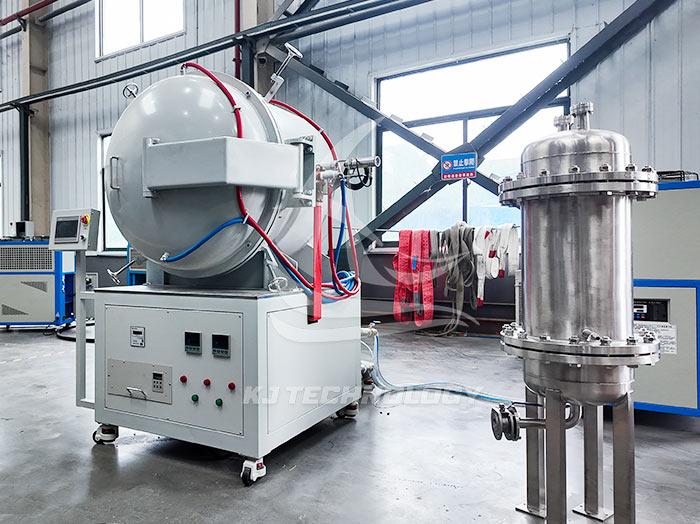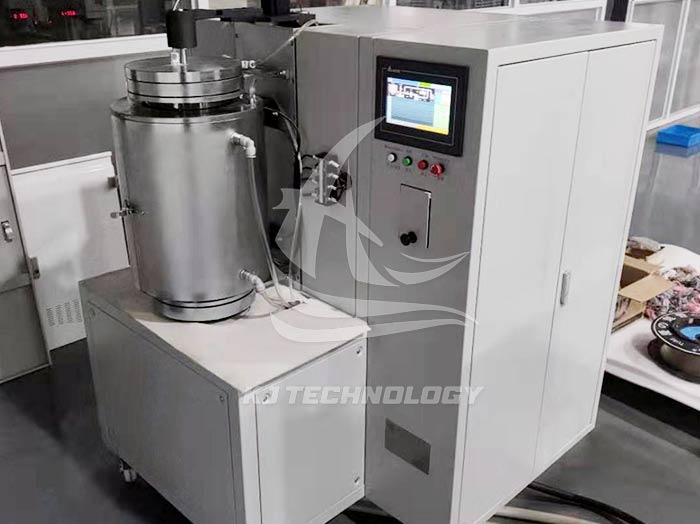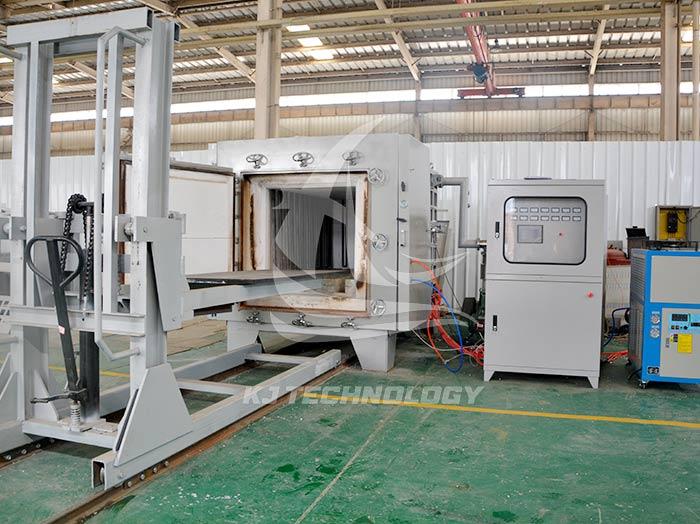Precautions for using electric heating vacuum brazing furnace
 09-24-2025 Author: KJ technology
09-24-2025 Author: KJ technology
As a high-precision heat treatment equipment, the use of electric heating vacuum brazing furnace involves high temperature, high pressure, vacuum environment and complex process control. Improper operation can easily lead to equipment damage, process failure or safety accidents. The following are key precautions when using an electric heating vacuum brazing furnace, covering preparation before operation, monitoring during operation, and maintenance:
1. Preparation before operation
Equipment inspection
Vacuum system: Check the oil level and quality of the vacuum pump (whether it is emulsified or contaminated), and confirm that there is no leakage in the pump body; Check whether the vacuum valve and pipeline connections are tightened, and whether the sealing ring is aged or damaged.
Heating system: Check whether the heating elements (such as resistance wires, graphite heaters) are loose or damaged, and measure whether the resistance value meets the requirements; Confirm that the thermocouple is installed in the correct position and has good contact.
Cooling system: Check the flow rate, pressure, and temperature of the cooling water (usually requiring a water pressure of 0.1-0.15MPa and a water temperature of 15-30 ℃) to ensure that the water pump is running normally and the pipeline is not blocked or leaking.
Electrical system: Check whether the power supply voltage is stable (avoid phase loss or overvoltage), confirm that the wiring inside the control cabinet is not loose, and the grounding is good.
Mechanical transmission: Check whether the mechanical components such as furnace door lifting and workpiece rotation are sufficiently lubricated, and whether the limit switch is sensitive and reliable.
Workpiece preparation
Cleanliness: The surface of the workpiece should be thoroughly cleaned to remove oil stains, oxide scales, and impurities, in order to avoid contaminating the furnace environment or affecting the quality of brazing.
Furnace loading capacity: Control the furnace loading capacity of the workpiece to avoid uneven heat distribution or decreased vacuum degree caused by excessive density.
Material compatibility: Confirm that the workpiece material has no adverse reactions with the brazing material and protective gas (such as argon), and avoid the generation of harmful gases or corrosion of the furnace body at high temperatures.
Environmental Requirements
Keep the area around the furnace clean and free of flammable and explosive materials; Ensure good ventilation and avoid the accumulation of high-temperature or harmful gases.
Operators need to wear protective equipment (such as insulated gloves and goggles) to avoid direct contact with high-temperature components.
2. Running process monitoring
Vacuum pumping stage
Extraction rate: Monitor the rate of vacuum rise, and if it is abnormally slow, check whether the vacuum pump, valve, or pipeline is leaking.
Vacuum degree control: Set the target vacuum degree (such as 10 ⁻³ -10 ⁻⁴ Pa) according to the process requirements to avoid insufficient vacuum degree causing solder oxidation or porosity defects.
Baking and degassing: For processes that require high vacuum, it is necessary to bake for a long time in a low temperature range (such as 150-200 ℃) to remove gases adsorbed on the surface of the workpiece.
heating phase
Heating rate: Strictly control the heating rate according to the process curve to avoid excessive deformation of the workpiece or splashing of the brazing material.
Temperature uniformity: Monitor the temperature distribution inside the furnace through thermocouples or infrared thermometers, and adjust the heating element power or workpiece placement position if necessary.
Insulation time: Ensure sufficient insulation time to fully melt the brazing material and fill the gaps, avoiding under welding or over welding.
cooling phase
Cooling method: Choose air cooling (such as filling with high-purity argon gas) or water cooling according to process requirements, control the cooling rate to avoid workpiece cracking or excessive residual stress.
Cooling medium: Ensure sufficient cooling water flow to avoid equipment damage or decreased workpiece performance due to insufficient cooling.
security monitoring
Pressure protection: Install overvoltage and undervoltage alarm devices to prevent equipment damage caused by vacuum or cooling system failures.
Overtemperature protection: Equipped with an independent overtemperature protection device to prevent the heating element from losing control and causing damage or fire to the furnace body.
Emergency stop: Familiarize yourself with the position and operation method of the emergency stop button, immediately stop the machine in case of abnormal situations, and investigate the cause.
3. Maintenance and upkeep
routine maintenance
Cleaning the furnace body: Clean the residue, oxides, and splashes inside the furnace after each use to keep the furnace clean.
Check seals: Regularly inspect the sealing rings of furnace doors, flanges, and other parts, and replace aging or damaged parts in a timely manner.
Lubricate mechanical components: Regularly add lubricating oil to the furnace door lifting mechanism, workpiece rotating device, etc. to ensure flexible operation.
regular maintenance
Vacuum pump maintenance: Replace the vacuum pump oil, clean the oil circuit and filter every 500-1000 hours of operation; Check the wear of the shaft seal and replace it if necessary.
Heating element detection: Measure the resistance value of the heating element every six months to confirm that there is no short circuit or open circuit; Check if the graphite heater is cracked or oxidized.
Cooling system cleaning: Clean the cooling water pipeline annually to remove scale and impurities, ensuring cooling efficiency.
Electrical system inspection: Check whether the wiring inside the control cabinet is loose, whether the insulation resistance meets the standard, and avoid electrical faults.
Long term disuse maintenance
Vacuum Maintenance: If the equipment is not in use for a long time, it is necessary to maintain the vacuum state inside the furnace (or fill it with dry nitrogen) to avoid humid air entering and causing corrosion.
Rust prevention treatment: Apply rust proof oil to metal parts to prevent rusting.
Regular startup: Start the equipment every 2-3 weeks and run it empty to check if all systems are functioning properly and avoid component jamming or aging.
4. Safety operation standards
Training and Qualification: Operators need to undergo professional training, familiarize themselves with equipment structure, process principles, and safety operating procedures.
Prohibition of illegal operations: It is strictly prohibited to open the furnace door while the vacuum pump is running; Do not start heating when flammable and explosive gases are present in the furnace.
Emergency response: Develop emergency plans and conduct regular drills on the handling procedures for unexpected situations such as fires and leaks.
Recording and tracing: Establish equipment operation logs to record key data such as temperature, vacuum degree, and process parameters for problem tracing and process optimization.








